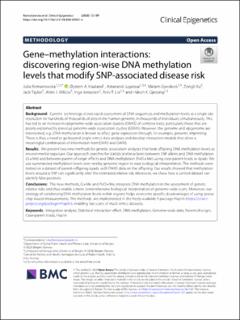| dc.contributor.author | Romanowska, Julia | |
| dc.contributor.author | Haaland, Øystein Ariansen | |
| dc.contributor.author | Jugessur, Astanand | |
| dc.contributor.author | Gjerdevik, Miriam | |
| dc.contributor.author | Xu, Zongli | |
| dc.contributor.author | Taylor, Jack A. | |
| dc.contributor.author | Wilcox, Allen J | |
| dc.contributor.author | Jonassen, Inge | |
| dc.contributor.author | Lie, Rolv T. | |
| dc.contributor.author | Gjessing, Håkon K. | |
| dc.date.accessioned | 2021-08-04T08:44:10Z | |
| dc.date.available | 2021-08-04T08:44:10Z | |
| dc.date.created | 2020-01-17T12:08:05Z | |
| dc.date.issued | 2020 | |
| dc.identifier.issn | 1868-7075 | |
| dc.identifier.uri | https://hdl.handle.net/11250/2766120 | |
| dc.description.abstract | Background
Current technology allows rapid assessment of DNA sequences and methylation levels at a single-site resolution for hundreds of thousands of sites in the human genome, in thousands of individuals simultaneously. This has led to an increase in epigenome-wide association studies (EWAS) of complex traits, particularly those that are poorly explained by previous genome-wide association studies (GWAS). However, the genome and epigenome are intertwined, e.g., DNA methylation is known to affect gene expression through, for example, genomic imprinting. There is thus a need to go beyond single-omics data analyses and develop interaction models that allow a meaningful combination of information from EWAS and GWAS.
Results
We present two new methods for genetic association analyses that treat offspring DNA methylation levels as environmental exposure. Our approach searches for statistical interactions between SNP alleles and DNA methylation (G ×Me) and between parent-of-origin effects and DNA methylation (PoO ×Me), using case-parent triads or dyads. We use summarized methylation levels over nearby genomic region to ease biological interpretation. The methods were tested on a dataset of parent–offspring dyads, with EWAS data on the offspring. Our results showed that methylation levels around a SNP can significantly alter the estimated relative risk. Moreover, we show how a control dataset can identify false positives.
Conclusions
The new methods, G ×Me and PoO ×Me, integrate DNA methylation in the assessment of genetic relative risks and thus enable a more comprehensive biological interpretation of genome-wide scans. Moreover, our strategy of condensing DNA methylation levels within regions helps overcome specific disadvantages of using sparse chip-based measurements. The methods are implemented in the freely available R package Haplin (https://cran.r-project.org/package=Haplin), enabling fast scans of multi-omics datasets. | en_US |
| dc.language.iso | eng | en_US |
| dc.publisher | BMC | en_US |
| dc.rights | Navngivelse 4.0 Internasjonal | * |
| dc.rights.uri | http://creativecommons.org/licenses/by/4.0/deed.no | * |
| dc.title | Gene-methylation interactions: Discovering region-wise DNA methylation levels that modify SNP-associated disease risk | en_US |
| dc.type | Journal article | en_US |
| dc.type | Peer reviewed | en_US |
| dc.description.version | publishedVersion | en_US |
| dc.rights.holder | Copyright 2020 The Authors | en_US |
| dc.source.articlenumber | 109 | en_US |
| cristin.ispublished | true | |
| cristin.fulltext | original | |
| cristin.qualitycode | 1 | |
| dc.identifier.doi | 10.1186/s13148-020-00881-x | |
| dc.identifier.cristin | 1775705 | |
| dc.source.journal | Clinical Epigenetics | en_US |
| dc.relation.project | Norges forskningsråd: 262700 | en_US |
| dc.relation.project | Bergens forskningsstiftelse: 807191 | en_US |
| dc.relation.project | Norges forskningsråd: 245464 | en_US |
| dc.identifier.citation | Clinical Epigenetics. 2020, 12, 109. | en_US |
| dc.source.volume | 12 | en_US |

